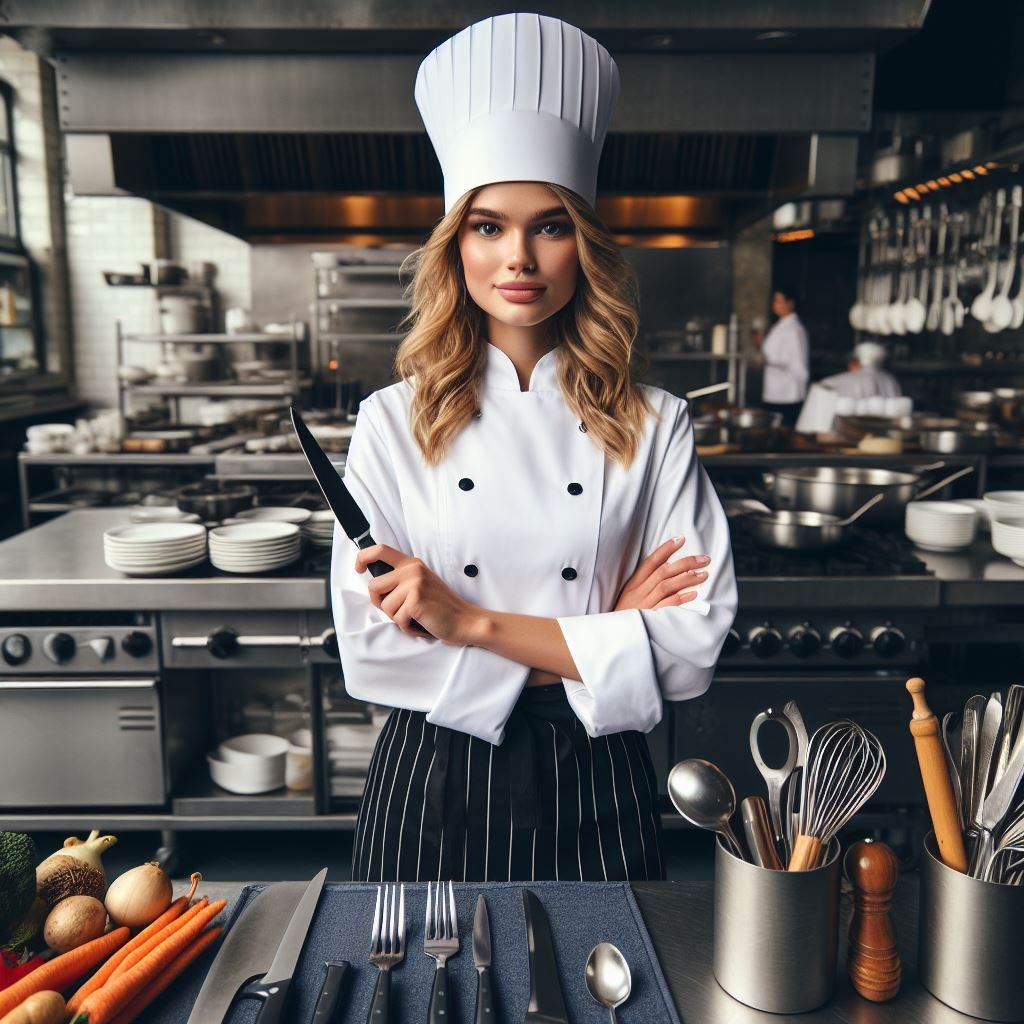Introduction
Culinary tourism refers to the exploration of food and beverages as the primary motivator for travel. lets discuss on Female Chefs in Australia Kitchens
It involves experiencing local cuisines, culinary traditions, and food-related activities in different destinations.
The purpose of this blog post is to explore the burgeoning trend of culinary tourism and its significance in the travel industry.
We will delve into the reasons behind the growing popularity of culinary tourism, its impact on local economies and cultures, and provide tips for travelers interested in embarking on culinary adventures.
Through this exploration, we aim to showcase the richness and diversity of culinary experiences around the world and inspire readers to indulge their taste buds while exploring new destinations.
Historical Context
Traditional gender roles in Australian kitchens
Traditional gender roles in Australian kitchens were deeply entrenched, reflecting societal norms and expectations.
Men typically held positions of authority and expertise, while women were relegated to supporting roles such as kitchen assistants, pastry chefs, or home cooks.
This division of labor stemmed from historical perceptions of gender roles, with men seen as the primary breadwinners and women as caretakers within the household.
As a result, kitchens were often viewed as male-dominated spaces where culinary prowess was associated with masculinity.
Lack of representation of female chefs in the past
Throughout history, the representation of female chefs in Australian kitchens has been limited, with women facing numerous obstacles and barriers to entry in the culinary profession.
In the past, culinary education and apprenticeships were often inaccessible to women, who were discouraged from pursuing careers in professional cooking.
As a result, female chefs were underrepresented in restaurant kitchens and culinary leadership positions, perpetuating the stereotype that cooking was primarily a male domain.
This lack of representation not only hindered the career progression of aspiring female chefs but also contributed to the marginalization and undervaluation of their contributions to the culinary industry.
The Changing Landscape
Factors contributing to the rise of female chefs
Over the past decade, the culinary industry in Australia has seen a remarkable increase in the number of female chefs. To accurately gauge the impact and identify progress, it is vital to consider recent statistics on female representation in the industry.
According to a study conducted by the Australian Culinary Federation, in collaboration with various culinary institutions and organizations, the latest data reveals a considerable rise in the number of female chefs across the country.
Current statistics on female representation in the industry
One of the key findings of the study shows that women now make up approximately 40% of all culinary professionals in Australia. This is a significant increase from just a decade ago when the figure stood at a mere 25%.
The industry has witnessed a 15% rise in female representation, indicating a considerable shift in gender dynamics.
Specifically, the top positions within professional kitchens have seen a notable increase in female representation. Head chef roles, which were previously overwhelmingly occupied by men, now comprise around 36% women.
Executive chef positions have experienced a similar positive trend, with women currently holding approximately 30% of these influential positions. These figures highlight the changing face of the culinary industry.
Furthermore, culinary schools and vocational training institutes have witnessed an influx of women seeking formal education and culinary training.
In response to this demand, these institutions have increasingly developed specialized programs tailored to the needs of aspiring female chefs, enabling them to receive the necessary skills and knowledge to excel in the profession.
While the industry still faces challenges such as wage gaps and gender biases, the increasing representation of women in professional kitchens is undoubtedly a positive and long-overdue change.
With a continued emphasis on equality and inclusivity, the future holds great promise for female chefs in Australia and their contributions to the culinary world.
Read: Travel Agents: The Future in Aussie Tourism
Challenges Faced by Female Chefs
Gender bias and discrimination
- Female chefs often face gender bias in the culinary industry, where their skills and expertise are questioned solely based on their gender.
- They encounter discrimination in the form of lower pay, fewer job opportunities, and limited chances for career advancement.
- Many female chefs struggle to be taken seriously and receive the same recognition as their male counterparts.
- The perception that women are better suited for domestic cooking than professional kitchens persists, hindering their progress.
- Overcoming these biases and breaking through the traditional gender roles remains an ongoing battle for female chefs.
Work-life balance issues
- Balancing work with personal life is a significant challenge for female chefs, especially those with families.
- The demanding nature of the culinary profession, including long hours and irregular schedules, often conflicts with family commitments.
- Women often find it difficult to juggle their career aspirations with the desire to have a fulfilling personal life.
- Lack of flexibility in the industry makes it challenging for female chefs to accommodate their family obligations.
- Achieving work-life balance is crucial for the overall well-being and career longevity of female chefs.
Lack of support networks and mentorship
- Female chefs often lack access to strong support networks within the industry, which can hinder their professional growth.
- The traditionally male-dominated kitchen culture may exclude women from informal networks and valuable connections.
- Female chefs face a scarcity of mentorship opportunities, with fewer experienced women in leadership positions.
- Mentoring programs and initiatives specifically for women in the culinary field are crucial to address this gap.
- Establishing support networks and mentorship programs can empower and inspire female chefs to achieve their full potential.
In essence, female chefs in Australia face various challenges in their profession, including gender bias and discrimination, work-life balance issues, and a lack of support networks and mentorship.
Overcoming these obstacles requires a collective effort from the culinary industry to promote gender equality and provide opportunities for women to thrive.
By addressing these challenges, Australia can ensure that talented female chefs have the same opportunities for success as their male counterparts, leading to a more diverse and inclusive culinary landscape.
Read: How to Become a Travel Agent in Australia
Success Stories
Inspiring female chefs in Australia
When it comes to the culinary world, Australia has seen a significant rise in the number of female chefs taking charge of kitchens.
Your Personalized Career Strategy
Unlock your potential with tailored career consulting. Get clear, actionable steps designed for your success. Start now!
Get StartedThese inspiring women have not only pushed the boundaries but also shattered glass ceilings, making their mark in an industry traditionally dominated by men.
Their journey and achievements
One of the most prominent success stories in Australia’s culinary scene is Kylie Kwong.
From an early age, Kwong immersed herself in the world of food, influenced by her Chinese-Australian heritage.
After honing her craft in various kitchens, she opened her celebrated restaurant Billy Kwong in Sydney, where she combined modern techniques with traditional Chinese flavors.
Her commitment to sustainability and ethically sourced produce earned her widespread acclaim and a loyal following.
Today, Kwong is not only known for her inventive cuisine but also her advocacy for community and cultural inclusion.
Through her television appearances and cookbooks, she has showcased fresh, local ingredients and encouraged home cooks to embrace diversity in the kitchen.
Kwong’s dedication, creativity, and leadership continue to inspire aspiring female chefs looking to make their mark on the Australian culinary landscape.
Another inspiring female chef is Christine Manfield. Her culinary journey began in the 1980s, and she went on to establish a successful career as a chef, author, and restaurateur.
Manfield’s innovative approach to flavors and her dedication to promoting diversity in Australian cuisine have made her a role model for aspiring female chefs.
She has shown that with a strong vision and determination, women can thrive in the culinary world.
Overcoming obstacles and breaking barriers
Overcoming obstacles and breaking barriers is not an easy task, but these female chefs have managed to do just that.
Poh Ling Yeow, a Malaysian-born Australian chef, rose to fame after participating in the first season of the TV show “MasterChef Australia”.
Despite facing criticism and stereotypes, she persevered and has since become a successful chef, cookbook author, and television presenter.
Yeow’s journey serves as an inspiration for aspiring female chefs, proving that hard work and passion can lead to success.
Role models for aspiring female chefs
Role models play a crucial role in shaping the aspirations of future generations. Female chefs like Alla Wolf-Tasker have become role models for aspiring women in the culinary industry.
Wolf-Tasker is the co-owner and executive chef of Lake House, a renowned restaurant in regional Victoria.
She has been recognized for her dedication to using local and seasonal produce, as well as her commitment to mentoring young chefs.
Her influence extends beyond the kitchen, making her an inspiration for aspiring female chefs.
Stand Out with a Resume That Gets Results
Your career is worth more than a generic template. Let us craft a resume and cover letter that showcase your unique strengths and help you secure that dream job.
Get HiredThese success stories highlight the achievements of female chefs in Australia’s culinary scene.
Through their perseverance and determination, they have paved the way for aspiring women in the industry.
By breaking barriers and serving as role models, these chefs have inspired a new generation of female culinary professionals.
As the number of female chefs continues to rise, it is clear that women are making their mark and shaping the future of Australian kitchens.
Read: Travel Agents: Trends in Australia for 2024

The Impact on the Culinary Scene
Diverse perspectives and creativity in Australian cuisine
- Female chefs bring new and unique perspectives to the culinary scene in Australia.
- Their creativity and innovative approach to cooking contribute to the evolution of Australian cuisine.
- By introducing different flavors and techniques, they add diversity to the culinary landscape.
- Female chefs often draw inspiration from their cultural backgrounds and incorporate it into their dishes.
- This infusion of diverse perspectives results in a vibrant and exciting culinary scene.
Influences on menu planning and innovation
- The rise of female chefs has had a significant impact on menu planning in Australian restaurants.
- Their culinary expertise allows for the introduction of new and exciting dishes on menus.
- Female chefs often focus on using locally sourced and seasonal ingredients, promoting sustainability.
- They prioritize freshness and quality in their dishes, which resonates with customers.
- The innovation brought by female chefs has led to a more dynamic dining experience for consumers.
- Their influence can be seen in the incorporation of global flavors and fusion cuisine in menus.
- Female chefs have also played a key role in introducing healthier options and accommodating dietary restrictions.
- Their attention to detail and emphasis on presentation have elevated the dining experience in Australia.
In fact, the rise of female chefs in Australia’s kitchens has made a significant impact on the culinary scene.
Their diverse perspectives and creativity have brought new flavors, techniques, and innovation to Australian cuisine.
Menu planning has been influenced by their culinary expertise, leading to the introduction of exciting dishes and a focus on sustainability and quality.
Additionally, female chefs have contributed to a more dynamic dining experience through the incorporation of global flavors, healthier options, and attention to presentation.
As the presence and influence of female chefs continue to grow, the Australian culinary scene will only become more vibrant and diverse.
Read: Salary Guide: Travel Agents in Australia
Gain More Insights: Essential Bar Tools for Aussie Bartenders
Initiatives Supporting Female Chefs
Women-led culinary organizations and events
- Women in Hospitality (WiH) Australia actively supports female chefs in the industry.
- Women Chefs & Restaurateurs (WCR) promotes networking and professional development opportunities for women chefs.
- Food Feminists is a platform that champions female chefs, creating a community and offering support.
- Women in Foodservice Charity (WIFC) organizes events and fundraisers to empower women in the culinary field.
Mentorship programs and scholarships:
- Chefin is an organization offering mentorship programs to aspiring female chefs, helping them thrive in their careers.
- Restaurant and Catering Australia (R&CA) provides scholarships to female chefs to enhance their skills and knowledge.
- The Stephanie Alexander Kitchen Garden Foundation supports female chefs by offering apprenticeships and mentorship opportunities.
- The TAFE Queensland Women Chef Program provides training and mentorship to women pursuing a career in the culinary arts.
Future Outlook
Opportunities for further growth and progress
- With an increasing number of female chefs in Australia, the culinary industry has great potential for further growth.
- Restaurants and food establishments can tap into this talent pool by providing more opportunities for female chefs to excel.
- Female chefs bring a unique perspective and style to the kitchen, attracting a diverse customer base and enhancing the culinary experience.
- By embracing and supporting female chefs, the industry can foster innovation, creativity, and a healthy competitive spirit.
- There is a growing demand for female chefs in the catering industry, providing another avenue for women to showcase their culinary skills and entrepreneurship.
- Investing in training programs and mentorship opportunities specifically designed for aspiring female chefs can further drive growth and innovation in the industry.
- Female chefs can take advantage of the rise of social media platforms to promote their personal brands and reach a wider audience, opening doors for collaborations and business opportunities.
- With the increasing interest in sustainable and plant-based cuisine, female chefs can play a crucial role in shaping the future of food and influencing culinary trends.
- The rise of female chefs in Australia’s kitchens has the potential to break down gender stereotypes and pave the way for equality in the culinary industry.
Encouraging more women to enter the culinary industry
- Creating awareness about the opportunities and success stories of female chefs can inspire more women to pursue careers in the culinary industry.
- Collaborative initiatives between culinary schools, industry professionals, and organizations can provide scholarships and internships specifically for aspiring female chefs.
- Addressing the gender pay gap and offering equal opportunities for growth and advancement can attract more women to the field.
- Promoting work-life balance and flexible schedules can help women overcome the challenges of balancing personal and professional responsibilities.
- Recognizing and celebrating the achievements of female chefs through awards and accolades can showcase their talent and inspire future generations.
- Women’s culinary networks and mentorship programs can provide a support system and guidance for aspiring female chefs.
- Encouraging partnerships and collaborations between established female chefs and aspiring talent can create opportunities for knowledge sharing and skill development.
- Education institutions can incorporate more female chefs in their curriculum and invite guest lectures to provide inspiration and firsthand experience to students.
- Highlighting the positive impact of female leadership in the culinary industry can attract more women to managerial roles and overall industry growth.
To summarize, the future outlook for the rise of female chefs in Australia’s kitchens is promising.
With opportunities for further growth and progress, alongside efforts to encourage more women to enter the culinary industry, we can expect a more diverse and inclusive landscape in the years to come.
You Might Also Like: Technology in Tour Guiding: A Boon?
Explore Further: Aussie Chef Salaries: Expectations vs Reality
Conclusion
In closing, female chefs in Australia’s kitchens have experienced a significant rise in recent years. They have broken barriers and challenged the traditional male-dominated culinary field.
It is crucial to emphasize the importance of continued support and recognition for women in the culinary industry. This support can enable their growth, inspire future generations, and bring diversity and innovation to the field.
Female chefs have proven their skill, creativity, and passion in the kitchen. Their contributions are essential for the advancement of the Australian culinary scene.
Transform Your LinkedIn for Maximum Impact
Elevate your professional brand with a LinkedIn profile that attracts recruiters, showcases your expertise, and maximizes opportunities. Stand out in your industry with a profile built for success.
Boost ProfileAs the number of women in culinary leadership positions continues to grow, it is vital for the industry and society as a whole to appreciate their talent and provide equal opportunities.
By highlighting the achievements and successes of female chefs, we can promote a more inclusive and diverse culinary landscape in Australia.
It is clear that the rise of female chefs is not just a trend, but a movement that signifies progress and equality within the culinary field.
In closing, let us continue to support and champion women in the kitchen, ensuring that they receive the recognition they deserve and reshaping the future of Australian gastronomy.




